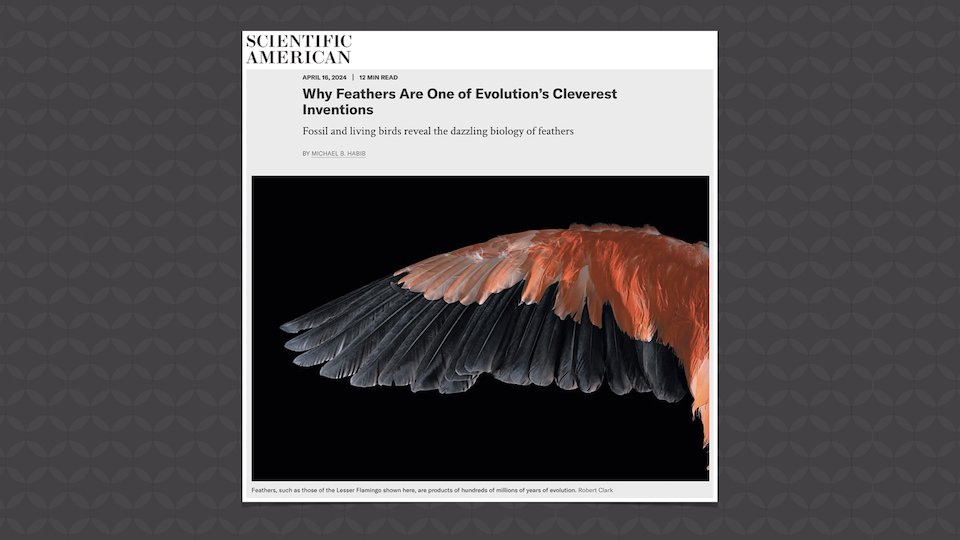
Are Feathers One of Evolution’s Cleverest Inventions?
A recent article made the bold claim that feathers are one of evolution’s greatest inventions. But what proof did they offer? None, but they did provide a lot of imaginative storytelling and a clear refusal to recognize that objects showing incredible design could not have come about by random chance mutations.
Yet as the title of the article shows, they ascribe intelligence and creativity to evolution, almost like it has a mind and can preplan for any situation. Well, evolution is really their religion to attempt to explain life and the universe without God.
One example of the design they mention is the resplendent quetzal. Small and colorful, this bird is native to the cloud forests of Mexico and Central America. During the breeding season, the tail feathers of male resplendent quetzals can grow up to three feet long, but these unique tail feathers let much of the airflow pass through without producing much drag on the bird (otherwise, it either wouldn’t be able to fly or at least not well). The researchers were surprised to learn that there’s a narrow range of flexibility that allows the male to show off these feathers to the best effect while minimizing negative impacts on flight performance. They made the statement that “display feathers, especially tail streamers, may also be more finely tuned than previously thought.” Ah, so evolution can fine-tune feathers. Evolution is looked upon as being an intelligence.
Next up was the facial disks of owls. They are not just decorative but also are effective in funneling sound to the owl’s ears. So much so that the owl primarily hunts by sound.
This led to another aspect of design: that owls make almost no sound when flying, thanks to the wing feathers’ “‘velvety’ surface that silences them when they move against one another.” The article discussed how each individual feather on the leading edge of an owl’s wing has a set of comblike structures, but those on the trailing edge have fluffy fringes. This allows owls to create an aerodynamic wake containing no waves of linear pressure and therefore allows them to be silent flyers. So how did owls reduce noise so that they can hear prey and also sneak up on them? According to the article, “Owls solved both problems by evolving feather traits that make them inaudible during flight.” Ah yes, evolution can foresee and solve problems. Yes, evolution is such a high intelligence.
Evolution can act as both planner (hummingbirds need to hover to eat) and engineer (so let’s redesign those shoulders and wings)?
Then they looked at hummingbirds, which are unique in how they fly, especially when hovering. Their wing feathers are much stiffer than any other bird, except for nonflying penguins, allowing them to hover in front of flowers while consuming nectar. Unlike most birds, hummingbirds can generate a substantial amount of lift and thrust from their upstroke as well as their downstroke, but this method only works because their wings are very stiff. Hummingbirds capitalize on this by rotating their shoulder to completely flip the wing over as they hover. And the evolutionary spin here? “Some of the most extreme feather adaptations are found in birds with the most extreme ecological specializations.” So, evolution can act as both planner (hummingbirds need to hover to eat) and engineer (so let’s redesign those shoulders and wings)?
Lastly, they looked at penguins, who also have ultra-stiff feathers. In essence, they use a rough coat of stiff feathers to minimize drag, therefore lowering the energetic cost of swimming. The dense feathers over their entire body also trap a small amount of air to provide some insulation without making the penguin too buoyant (or it couldn’t dive for food). This trapped air supplements the fat layer that insulates the bird to keep it warm. And how did evolution do this remarkable feat? Being flightless, “penguins jettisoned the more typical feather accoutrements of their ancestors in favor of a novel suit of drag-reducing, minimum-buoyancy feathers.” Evolution invents the buy-one-get-one-free function sale!
The author of the article, Michael B. Habib, gushes over the design of these birds and their feather designs yet attributes it all to a concept, not a designer. Imagine a poor “proto-penguin” standing at the edge of the water on some barren island and saying to himself, “I wish evolution would hurry up and redesign my feathers so I could get something to eat.”
That is a reification fallacy. Evolution cannot foresee, design, guide, or plan. Ultimately, this is stealing glory from God, the Master Designer, and attributing it to a hypothetical construct, evolution. As stated at the beginning of this blog post, no proof is offered: just wild speculation that “evolution did it.” As I’ve said before, evolution is a religion because it is a belief system about the past. How can an evolutionist believe things without rigorous scientific proof or with proofs that get adjusted radically every few years? The answer is that he wants to. There is a term for this type of belief system—that term is religion.
Evolution didn’t invent feathers. And the claim that feathers originated from dinosaurs has never been proven.
No, evolution didn’t invent feathers. And the claim that feathers originated from dinosaurs has never been proven. Evolutionary biologists have either redefined feathers (with filaments and “dino-fuzz” now being classified as “proto-feathers”), mislabeled actual birds as dinosaurs, or mislabeled dinosaurs as early birds. People are actively suppressing the truth in unrighteousness. Through his creation, God has made his existence and even some of his attributes plain to all. And yet, instead of attributing the incredible design of nature to God, many people praise nature or evolutionary processes—they’ve exchanged the Creator God, who died for mankind’s sin and who loves us, for the lie of evolution.
“For although they knew God, they did not honor him as God or give thanks to him, but they became futile in their thinking, and their foolish hearts were darkened.Claiming to be wise, they became fools,and exchanged the glory of the immortal God for images resembling mortal man and birds and animals and creeping things.” (Romans 1:21–23)
Get More Answers on Answers News
This item was discussed Monday on Answers News with cohosts Dr. Gabriela Haynes, Rob Webb, and Bryan Osborne. Answers News is our weekly news program filmed live before a studio audience here at the Creation Museum, broadcast on our Answers in Genesis YouTube channel, and posted to Answers TV. We also covered the following topics:
- Is a genetics start-up firm practicing eugenics?
- Could a sugar acid crucial for life have formed in interstellar clouds?
- Was an ancient Sri Lankan city built with advanced technology?
- And more!
Be sure to join us each Monday at 2 p.m. (ET) on YouTube or later that day on Answers TV for Answers News. You won’t want to miss this unique news program that gives science and culture news from a distinctly biblical and Christian perspective.
Thanks for stopping by and thanks for praying,
Ken
This item was written with the assistance of AiG’s research team.
Most Recent News
-
Dec. 15, 2025 from Ken Ham Blog
Are tomatoes “de-evolving” on the remote Galápagos islands?
-
Dec. 13, 2025 from Ken Ham Blog
God’s Word is clear: Noah’s flood was a global—completely covering the entire earth—event.

Answers in Genesis is an apologetics ministry, dedicated to helping Christians defend their faith and proclaim the good news of Jesus Christ.
- Customer Service 800.778.3390
- Available Monday–Friday | 9 AM–5 PM ET
- © 2025 Answers in Genesis



